Angela M. Gronenborn

Fellowship
Hans Fischer Senior Fellowship
Appointment
2025
Institution
University of Pittsburgh, School of Medicine
Department
Structural Biology
Hosts
Prof. Michael Sattler, Prof. Franz Hagn
Focus Group
In-cell 19F NMR of protein interactions
Short CV
Angela M. Gronenborn currently holds the UPMC Rosalind Franklin Professorship in the Department of Structural Biology, School of Medicine. She is also a Professor of Bioengineering and Chemistry at the University of Pittsburgh. She obtained her Ph.D. in organic chemistry from the University of Cologne (Germany). After post-doctoral training, she started her independent career at the National Institute of Medical Research in Mill Hill, London, and subsequently lead research groups at the Max Planck Institute in Munich, The Laboratory of Chemical Physics at the NIH and since 2006 at the University of Pittsburgh Medical School. Throughout her career, Dr. Gronenborn was involved in developing NMR methodology for characterizing structure, dynamics and function of biological macromolecules. In the area of HIV research, Dr. Gronenborn directs the Pittsburgh Center for HIV Protein Interactions (PCHPI).
Dr. Gronenborn serves on numerous Scientific Advisory Boards and held leadership positions in professional societies. She trained more than 50 graduate students and post-doctoral fellows and authored more that 500 peer-reviewed publications. She was elected to the National Academy of Sciences (US), the Norwegian Academy of Arts and Letters, the German National Academy of Sciences (Leopoldina) and the American Academy of Arts & Sciences.
Selected Awards
- 2022, Fellow of the Biophysical Society
- 2021, Biophysical Society Founders Award
- 2020, E. Bright Wilson Award in Spectroscopy
- 2019, Richard R. Ernst Prize in Magnetic Resonance
- 2019, American Society for Biochemistry and Molecular Biology Mildred Cohen Award in Biological Chemistry
- 2017, Weaver Lecture in Biophysics, UC Davis
- 2014, Life Sciences Award, Carnegie Science Foundation
- 2014, Linus Pauling Lectureship, Stanford University
- 2006, Eastern Analytical Symposium Award for Excellence in Magnetic Resonance
- 1992, National Institutes of Health Director's Award
Research Interests
Dr. Gronenborn is distinguished for the development and application of new nuclear magnetic resonance (NMR) methods for determining three-dimensional structures of biological macromolecules. Key contributions include the development of restrained molecular dynamics/simulated annealing algorithms and multidimensional, heteronuclear spectroscopic methods, which allowed the extension of conventional NMR methods to higher molecular weight systems. Notable recent structures comprise the HIV-1 Capsid protein. As an international leader in developing and harnessing the power of NMR for the study of three-dimensional structures of large proteins and protein complexes in solution, Dr. Gronenborn played a seminal role in opening a whole new era in research on protein structure, dynamics, and function. Her work, both alone and in collaboration, has made possible the determinations of structures in solution that were once impossible tasks.
The methods that she developed are used in scores of academic and industrial laboratories throughout the world, and the structures resulting from this work and the understanding of their roles in biological function and structure-based drug design constitute the greatest legacy of her research. Throughout her career she has conducted interdisciplinary work to address important biological and biomedical questions. Most recently she has moved beyond the traditional “divide-and-conquer” approach in structural biology and is now studying systems in near native environments and in cells. For this she exploits 19F as a reporter nucleus, given its absence from virtually all naturally occurring biological systems. Fluorine is a uniquely attractive nucleus for NMR studies in near native environments and in cells as it is 100 %-abundant, and the 19F isotope is highly sensitive as well as exquisitely responsive to its local environment.
Selected Publications
- Yang DT, Chong LT, Gronenborn AM. Illuminating an invisible state of the HIV-1 capsid protein CTD dimer using 19F NMR and weighted ensemble simulations. Proc Natl Acad Sci. 2025 Feb 18; 122 (8) e2420371122 (#549)
- Gronenborn AM. Championing fundamental discovery research: quality over quantity. FEBS J. 2025 Jan 3. doi: 10.1111/febs.17386. PMID: 39754354. (#545)
- Bhinderwala F, Gronenborn AM. Exploiting 19F NMR in a Multiplexed Assay for Small GTPase Activity. J Am Chem Soc. 2025 Jan 8;147(1):1028-1033. doi: 10.1021/jacs.4c14294. PMID: 39693054; (#544)
- Zhu W, Guseman AJ, Bhinderwala F, Lu M, Su XC, Gronenborn AM. Visualizing Proteins in Mammalian Cells by 19 F NMR Spectroscopy. Angew Chem Int Ed Engl. 61 (23), e202201097 (2022). (# 521)
- Krzysiak TC, Thomas L, Choi Y-J, Auclair S, Qian Y, Luan S, Krasnow SM, Thomas LL, Koharudin LMI, Benos PV, Marks DL, Gronenborn AM, Thomas G. An insulin-responsive sensor in the SIRT1 disordered region binds DBC1 and PACS-2 to control enzyme activity. Molecular Cell, 72: 995-998, (2018). (# 493)
- Byeon, I.L., Meng, X., Jung, J., Zhao, G., Yang, R., Ahn, J., Shi, J., Concel, J., Aiken, C., Zhang, P., Gronenborn, A.M. Structural Convergence between CryoEM and NMR Reveals Novel Intersubunit Interactions Critical for HIV-1 Capsid Function. Cell 139, 780-790 (2009). (#399)
- Omichinski, J.G., Clore, G.M., Schaad, O., Felsenfeld, G., Trainor, C., Appella, E., Stahl, S.J. & Gronenborn, A.M. NMR structure of a specific DNA complex of Zn-containing DNA binding domain of GATA-1. Science 261, 438-446 (1993). (#211)
- Clore, G.M. & Gronenborn, A.M. Structures of larger proteins in solution: three- and four-dimensional heteronuclear NMR spectroscopy. Science 252, 1390 (1991). (#174)
- Oschkinat, H., Griesinger, C., Kraulis, P.J., Sørensen, O.W., Ernst, R.R., Gronenborn, A.M. & Clore, G.M. Three-dimensional NMR spectroscopy of a protein in solution. Nature 332, 374 (1988). (#113)
- Gronenborn, A.M., Birdsall, B., Hyde, E.I., Roberts, G.C.K., Feeney, J. & Burgen, A.S.V. Direct observation by NMR of two coexisting conformations of an enzyme-ligand complex in solution. Nature 290, 273 (1981). (#7)
https://amg.structbio.pitt.edu/wp-content/uploads/2025/01/AMG-FULL-BIBLIOGRAHY-2025-01.pdf